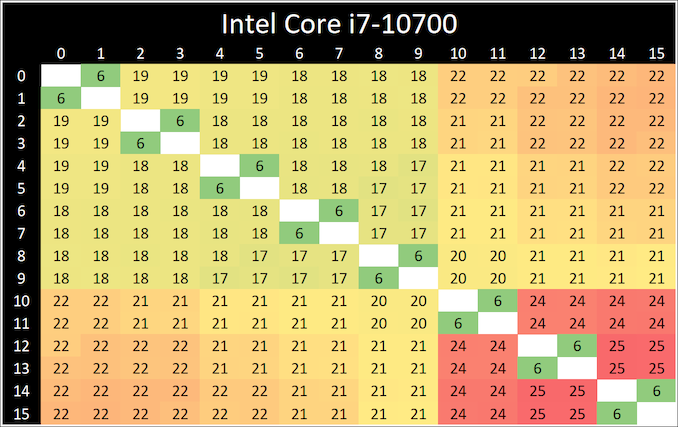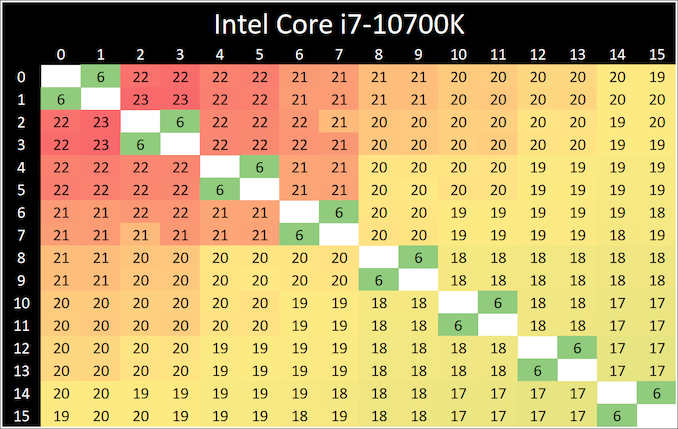Intel Core i7-10700 vs Core i7-10700K Review: Is 65W Comet Lake an Option?
by Dr. Ian Cutress on January 21, 2021 10:30 AM EST- Posted in
- CPUs
- Intel
- Core i7
- Z490
- 10th Gen Core
- Comet Lake
- i7-10700K
- i7-10700
CPU Tests: Microbenchmarks
Core-to-Core Latency
As the core count of modern CPUs is growing, we are reaching a time when the time to access each core from a different core is no longer a constant. Even before the advent of heterogeneous SoC designs, processors built on large rings or meshes can have different latencies to access the nearest core compared to the furthest core. This rings true especially in multi-socket server environments.
But modern CPUs, even desktop and consumer CPUs, can have variable access latency to get to another core. For example, in the first generation Threadripper CPUs, we had four chips on the package, each with 8 threads, and each with a different core-to-core latency depending on if it was on-die or off-die. This gets more complex with products like Lakefield, which has two different communication buses depending on which core is talking to which.
If you are a regular reader of AnandTech’s CPU reviews, you will recognize our Core-to-Core latency test. It’s a great way to show exactly how groups of cores are laid out on the silicon. This is a custom in-house test built by Andrei, and we know there are competing tests out there, but we feel ours is the most accurate to how quick an access between two cores can happen.
When we first reviewed the 10-core Comet Lake processors, we noticed that a core (or two) seemed to take slightly longer to ping/pong than the others. These two parts are both derived from the 10-core silicon but with two cores disabled, and we still see a pattern of some cores having additional latency. The ring on the 8-core parts still acts like a 10-core ring, but it all depends on which cores were disabled.
Frequency Ramping
Both AMD and Intel over the past few years have introduced features to their processors that speed up the time from when a CPU moves from idle into a high powered state. The effect of this means that users can get peak performance quicker, but the biggest knock-on effect for this is with battery life in mobile devices, especially if a system can turbo up quick and turbo down quick, ensuring that it stays in the lowest and most efficient power state for as long as possible.
Intel’s technology is called SpeedShift, although SpeedShift was not enabled until Skylake.
One of the issues though with this technology is that sometimes the adjustments in frequency can be so fast, software cannot detect them. If the frequency is changing on the order of microseconds, but your software is only probing frequency in milliseconds (or seconds), then quick changes will be missed. Not only that, as an observer probing the frequency, you could be affecting the actual turbo performance. When the CPU is changing frequency, it essentially has to pause all compute while it aligns the frequency rate of the whole core.
We wrote an extensive review analysis piece on this, called ‘Reaching for Turbo: Aligning Perception with AMD’s Frequency Metrics’, due to an issue where users were not observing the peak turbo speeds for AMD’s processors.
We got around the issue by making the frequency probing the workload causing the turbo. The software is able to detect frequency adjustments on a microsecond scale, so we can see how well a system can get to those boost frequencies. Our Frequency Ramp tool has already been in use in a number of reviews.
Both processors ramp from idle to full turbo in about six milliseconds, well within a single frame of standard gaming.













210 Comments
View All Comments
Oxford Guy - Sunday, January 24, 2021 - link
This site posted articles about overclocking that were done wildly, without true stability testing and with reckless amounts of voltage and you're going to now pretend that turning on XMP for RAM is some kind of terrible reckless matter?Oxford Guy - Sunday, January 24, 2021 - link
The thing is... if you wish to take a stand about JEDEC and company standards that's fine. Just don't post a lot of nonsensical reasons for it, like "Most users don't know how to plug in a computer so we're going to skip the plug for this review".Oxford Guy - Sunday, January 24, 2021 - link
Personally, here is all I'd say on the subject, were I to be taking your stand:'We use JEDEC standards for RAM speed because those are what AMD, Intel, and other CPU makers use to rate their chips. Anything beyond JEDEC is overclocking and is therefore running out of spec.
Although motherboard makers frequently choose to run CPUs out of spec, such as by boosting to the turbo speech and keeping it there indefinitely, and by including XMP profiles for RAM with lists of 'compatible' RAM running beyond JEDEC, it is our belief that the best place for a CPU's maximum supported RAM speech spec to come from is from the CPU's creator.
If anyone is unhappy about this standard we suggest lobbying the CPU makers to be more aggressive about officially supporting faster RAM speeds, such as by formally adopting XMP as a spec that is considered to be within spec for a CPU.
To compliment the goal of our JEDEC stance, are going to only create reviews using motherboards that fully comply with the turbo spec of vendors and/or disable all attempts by board makers to game that spec. If a board cannot be brought into full compliance we will refuse to post a review of it and any mention of it with the possible exception of a list of boards that run out of spec, are non-compliant.'
Qasar - Sunday, January 24, 2021 - link
Oxford Guy you seem to be quite unhappy about this review, and by other posts, the site as well, so if this site is so bad, WHY do you keep coming here ?Spunjji - Monday, January 25, 2021 - link
He's certainly not his own best advocate in that regard.I'd always defend someone's right to criticise aspects of something they otherwise like, but sometimes it goes a bit far.
Oxford Guy - Monday, January 25, 2021 - link
'but sometimes it goes a bit far.'Extreme vagueness + ad hom = extra fail.
Spunjji - Wednesday, January 27, 2021 - link
@Oxford Guy - 🙄1) That wasn't an ad-hominem - if you're going to do the "master debater" thing, at least learn to distinguish between commentary on the person and their argument.
2) Re: "extreme vagueness" - that was my personal opinion stated as a colloquialism. I don't owe anyone an annotated list of every comment you made, metric measurements of precisely how far they went, an objectively-defined scale of how far is too far, and a peer-reviewed thesis on the precise moment at which you exceeded that point.
Oxford Guy - Monday, January 25, 2021 - link
Ad hom... how unsurprising.To answer your question — This site is not bad. This site is good because people are able to give their honest opinions instead of living in a disgusting echo chamber like on ArsTechnica or Slashdot.
Perhaps that's where YOU should go instead.
Qasar - Tuesday, January 26, 2021 - link
why would i go there ? this site is top notch when it comes to reviews and comp hardware news. "This site is good because people are able to give their honest opinions " yes, but sometimes, some go to far with the whining and complaining :-)trenzterra - Friday, January 22, 2021 - link
Would be good if we could have some temperatures to compare as well. I used to buy the mid-end non-K Intel CPUs since I don't overclock but I always ended up with temperatures about 10 degrees higher than what most people report. With my latest build (ok, not that new now that it's actually a i5-6600k), I went for the K variant and temperatures are much better and in line with what most users report.